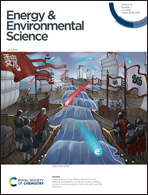A highly reversible zinc deposition for flow batteries regulated by critical concentration induced nucleation†
Abstract
Aqueous zinc-based flow batteries (ZFBs) represent one of the most promising energy storage technologies benefiting from their high safety and competitive energy density. However, the morphological evolution of Zn still remains vague but is significant in the electrolyte, whose Zn2+ concentration constantly decreases during Zn plating. Herein, we present a comprehensive experimental investigation on the morphological evolution and mechanism of deposited Zn in ZFBs and find that the formation of dense blocky Zn is controlled by instantaneous nucleation in concentrated electrolyte (≥0.4 M); in dilute electrolyte (≤0.3 M), Zn becomes mossy because of progressive nucleation. Simultaneously, the dominant plane of Zn crystals changes from (002) to (101). Besides, the recombination of Zn crystals on the same crystal plane was observed by in situ atomic force microscopy (AFM). Significantly, to maintain a high coulombic efficiency (CE >99.5%) and long cycling stability, an operating critical concentration range (≥0.4 M) and the optimized electrolyte utilization rate is proposed according to the Zn morphological evolution. This exploratory work will be beneficial for the further research of Zn anodes in electrochemical energy storage devices.



 Please wait while we load your content...
Please wait while we load your content...